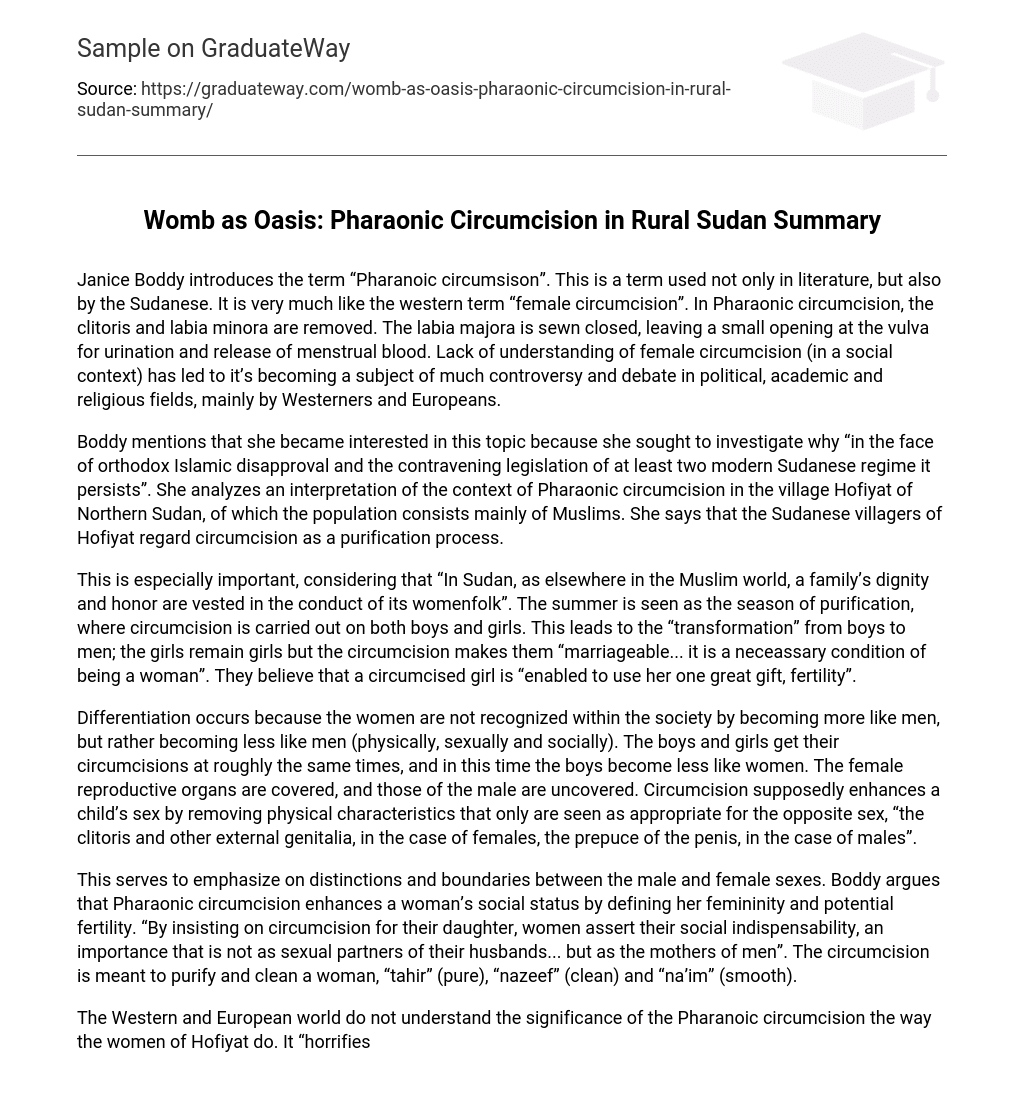Janice Boddy introduces the term “Pharanoic circumsison”. This is a term used not only in literature, but also by the Sudanese. It is very much like the western term “female circumcision”. In Pharaonic circumcision, the clitoris and labia minora are removed. The labia majora is sewn closed, leaving a small opening at the vulva for urination and release of menstrual blood. Lack of understanding of female circumcision (in a social context) has led to it’s becoming a subject of much controversy and debate in political, academic and religious fields, mainly by Westerners and Europeans.
Boddy mentions that she became interested in this topic because she sought to investigate why “in the face of orthodox Islamic disapproval and the contravening legislation of at least two modern Sudanese regime it persists”. She analyzes an interpretation of the context of Pharaonic circumcision in the village Hofiyat of Northern Sudan, of which the population consists mainly of Muslims. She says that the Sudanese villagers of Hofiyat regard circumcision as a purification process.
This is especially important, considering that “In Sudan, as elsewhere in the Muslim world, a family’s dignity and honor are vested in the conduct of its womenfolk”. The summer is seen as the season of purification, where circumcision is carried out on both boys and girls. This leads to the “transformation” from boys to men; the girls remain girls but the circumcision makes them “marriageable… it is a neceassary condition of being a woman”. They believe that a circumcised girl is “enabled to use her one great gift, fertility”.
Differentiation occurs because the women are not recognized within the society by becoming more like men, but rather becoming less like men (physically, sexually and socially). The boys and girls get their circumcisions at roughly the same times, and in this time the boys become less like women. The female reproductive organs are covered, and those of the male are uncovered. Circumcision supposedly enhances a child’s sex by removing physical characteristics that only are seen as appropriate for the opposite sex, “the clitoris and other external genitalia, in the case of females, the prepuce of the penis, in the case of males”.
This serves to emphasize on distinctions and boundaries between the male and female sexes. Boddy argues that Pharaonic circumcision enhances a woman’s social status by defining her femininity and potential fertility. “By insisting on circumcision for their daughter, women assert their social indispensability, an importance that is not as sexual partners of their husbands… but as the mothers of men”. The circumcision is meant to purify and clean a woman, “tahir” (pure), “nazeef” (clean) and “na’im” (smooth).
The Western and European world do not understand the significance of the Pharanoic circumcision the way the women of Hofiyat do. It “horrifies” them, but the Hofiyat women place it as the proclaimer of morally appropriate fertility (which, to them, is the epitome of femininity). This emphasizes their value of purity and cleanliness, which can also be traced throughout their culture. (e. g. Prophet Mohammad was white so all the white-skinned people have the favored position in his tribe, eating white foods were thought to increase the amount of blood in the body).
This brings the idea that relates blood to life and clean nourishment. The men brings structure (bones) to the social order, and the women bring fluidity and integration (blood). This comes from the child receiving it’s bones from the father, and flesh and blood from the mother. Boddy mentions that before Pharaonic circumcision could be stopped as a practice from the Hofiyat people, the Westerners and those horrified by the concept should first learn to understand the importance of circumcision in Sudanese culture. Their lives essentially “revolve” around the values and motives that encourage the continuation of the practice.





